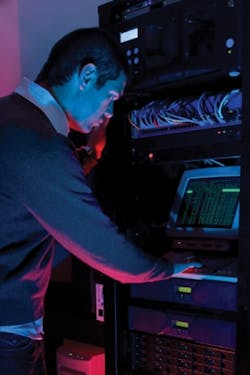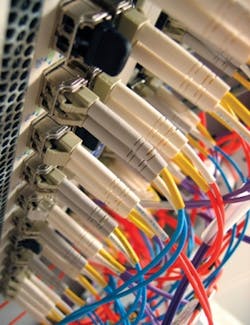Industry associations put forth standards for data centers
The specifications produced by the Telecommunications Industry Association and BICSI can be valuable references for professionals who design, build or manage cabling systems in data center facilities.
by Patrick McLaughlin
Two associations of particular relevance to professionals in the North American structured cabling industry have produced multiple sets of specifications aimed at ensuring the cabling and other systems installed in data center environments are robust and efficient. The two organizations, the Telecommunications Industry Association (TIA; www.tiaonline.org) and BICSI (www.bicsi.org), take approaches that result in complementary specifications. Cabling professionals who work in data centers are best-prepared for the challenges they face if they are familiar with both organizations’ offerings rather than one or the other.
In March 2011, BICSI released ANSI/BICSI-002-2011 Data Center Design and Implementation Best Practices. The standard includes requirements, recommendations and additional information that should be considered when planning and building a data center, BICSI says, such as site selection, layout, thermal systems and security.
BICSI-002, as it is frequently called for short, addresses a significant need for today’s data center designer, BICSI explains. With the push for greater capacity, increased efficiency and higher levels of utilization, data centers have become more complex to design and bring online. Because of this, today’s data center designer is often required to have knowledge in mechanical, electrical and telecommunications systems—areas typically not found within a single reference manual or standard.
Jonathan Jew, principal of J&M Consultants (www.j-and-m.com), who served as lead editor of BICSI-002 and is co-chair of BICSI’s Data Center Standards Committee, commented at the time of the standard’s publication, “BICSI-002 is a great resource for data center designers and operators because it provides a wealth of information on the subjects important to this audience, all in one place. It is the culmination of the efforts of more than 150 subject matter experts in a wide variety of disciplines related to data center design.”
BICSI explains that its data center design best-practices specification “integrated the key concepts and requirements from other documents and standards, while providing reference to specific documents where more considerations or information is available. This feature, unique to BICSI-002, provides a comprehensive document, which is applicable worldwide, with the risk of differences between documents minimized.”
TIA-942
The release of BICSI-002 straddled in time the release of the TIA’s original 942 Telecommunications Infrastructure Standard for Data Centers and that standard’s first revision, which will be TIA-942-A and is expected to be published in 2012. TIA’s original 942 standard was published in 2005. As its title indicates, the TIA-942 standard and its first revision are primarily concerned with the structured cabling systems deployed in data centers.
As we have reported in the past, the 942-A specifications will incorporate the following changes of significance for cabling professionals.
- Harmonization with the TIA-568-C standard series including topology, terms and environmental classifications described in 568-C.0, as well as component specifications in TIA-568-C.2 and C.3
- Incorporation of the two addenda to the original standard, TIA-942-1 and TIA-942-2
- Removal of grounding and bonding content (which was incorporated into TIA-607-B)
- Removal of administration content (which will be incorporated into TIA-606-B)
- Removal of most content regarding cabinets, racks and the separation of power and telecommunications circuits (which will be incorporated into TIA-569-C)
- Removal of outside-plant pathways content (which is being incorporated into TIA-758-B)
- Elimination of the 100-meter length limitation for fiber-optic horizontal cabling, in favor of basing distances on individual application requirements
- Elimination of Category 3 and Category 5e cabling as recognized media for horizontal cabling, leaving Category 6 and Category 6A as the recognized twisted-pair horizontal media
- Elimination of Om1 and Om2 as recognized multimode optical media for horizontal and backbone cabling, leaving Om3 and Om4 as the recognized media for these applications
- Recommendation of Om4, while still recognizing Om3, for horizontal and backbone cabling
- Recognition of the LC fiber-optic connector interface for two-fiber connections and of the MPO connector interface for connections of more than two fibers
- Addition of the intermediate distribution area to the data center topology
- Removal of an allowance for midspan powering equipment in the zone distribution area
- Addition of a section on energy efficiency
- Addition of the terms “equipment outlet” and “external network interface,” taken from the ISO/IEC 24764 standard
J&M’s Jew also has been playing a central role in the development of TIA-942-A, as he did with the original 942 standard and with BICSI-002. While BICSI-002 was still under development, we asked him about the extent to which BICSI-002 would either overlap with or complement TIA-942 and other data center specifications. He explained, “BICSI-002 does a pretty good job complementing TIA, CENELEC and ISO/IEC data center standards. We were careful not to duplicate content. The BICSI best practices document exceeds the minimum requirements where appropriate and it provides a lot of content in areas not covered by the TIA standard, including architectural, security, electrical and mechanical systems.”
BICSI-002 is one of three documents upon which the association bases the written examination for its new Data Center Design Consultant (DCDC) credential. The test is also based on parts of BICSI’s Network Design Reference Manual and parts of its Electronic Safety and Security Design Reference Manual.
“Candidates for the DCDC designation are individuals involved in the planning, implementing and making of critical decisions regarding data centers,” BICSI says. “Data center, IT, facility or project managers, architects, engineers, designers, consultants and those planning to enter careers in the data center design, construction or maintenance fields are encouraged to sit for the DCDC examination.”
Grounding and bonding
In addition to standards related to data center design and construction, BICSI and TIA also both have published standards related to the grounding and bonding of telecommunications systems.
In early 2011 the TIA published ANSI/TIA-607-B Generic Telecommunications Bonding and Grounding (Earthing) for Customer Premises. The previous version of the standard, ANSI-J-STD-607-A, did not include information on bonding from the telecommunications space to the racks; ANSI/TIA-607-B incorporates grounding all the way from a building’s entrance facility to the equipment racks.
The TIA’s 607-B standard incorporates a new component—the telecommunications equipment bonding conductor or TEBC. It runs from the telecommunications grounding busbar (TGB) or telecommunications main grounding busbar (TMGB), to which each rack or cabinet is bonded. A telecommunications space may have multiple TEBCs.
Meanwhile, BICSI collaborated with the National Electrical Contractors Association (NECA; www.necanet.org) to develop NECA-BICSI-607-2011 Standard for Telecommunications Bonding and Grounding Planning and Installation Methods for Commercial Buildings, which was published in the summer of 2011.
NECA issued a release upon the standard’s publication, saying it will help contractors and installers enhance the planning, specification and layout of an effective telecommunications bonding and grounding system. The standard also specifies installation requirements for components of the telecommunications bonding and grounding systems.
NECA’s executive director for standards and safety Mike Johnston said, “Telecommunications and information technology changes rapidly, but grounding and bonding is always fundamental to any electrical installation. A well-designed system is essential to protect equipment and personnel from harm. Correct, Code-compliant grounding and bonding installations will help ensure the long-term performance and safety of the system.”
BICSI concurred, stating that, “An effective telecommunications bonding and grounding system can prevent injury and equipment damage. With the complexity of today’s infrastructure with little margin for outages, any system, including the grounding and bonding network, can be the weakest link.”
BICSI also addressed NECA-BICSI-607 coexisting with the TIA grounding and bonding spec as well as the National Electrical Code when it said its newly introduced standard, “specifies aspects of planning and installation of telecommunications bonding and grounding systems. While this standard aligns with related standards, additional requirements and information for components and connectors of these systems are also included.”
While the NECA-BICSI-607 standard was written for commercial buildings and the ANSI/TIA-607-B standard is structured as a generic standard, they both have applicability to data center environments as well as commercial office space. For cabling design, installation and management professionals whose work frequently takes them inside data centers, the standards available to guide system specification would be enough to fill a briefcase.
Patrick McLaughlin is our chief editor.


